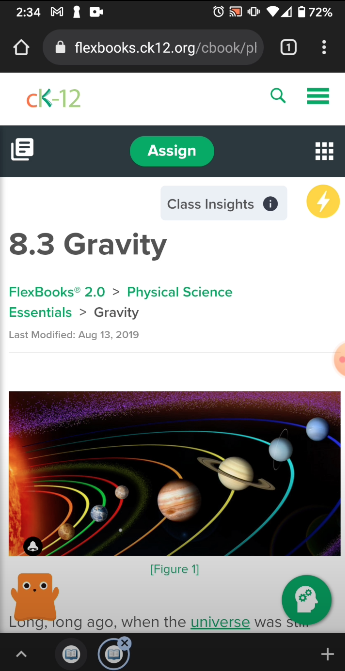
A textbook is an educational resource most students of the 20th century would be familiar with, but in the 21st, it seems to be falling out of vogue (at least in the K-12 system). While some more experienced professors and teachers still extol the virtue of their reliability, newly trained faculty dismiss them for their high cost and rigidity that fails to account for the unique needs of each student. I found myself between both camps during my 2016 practicum, which led me to my discovery of the not-for-profit CK-12 Foundation, and their mission to reinvent (or at least refine) the textbook for the internet age.
CK-12 embodies mobile and open learning. All resources are free and entirely customizable under a creative commons licence; users can quickly access lessons, simulations, real-world examples and appropriate videos relevant to their needs on both desktop and mobile devices. Their “Flexbooks 2.0” are amalgamations of these resources, typically grouped together by traditional subject matter and its relevant conceptual “chapters”. That said, the user can duplicate, copy, insert or delete whichever chapters, concepts or embedded elements (text, video, simulation etc.) suits their preference, and the “readings” (lessons) within each chapter are designed to encourage students to learn a concept in whatever way suits them, be it by playing around in an interactive simulation, reading about it on-screen or watching a Youtube video that explores the topic visually.
Each lesson also has an integrated AI assistant (the orange character known as “Flexi”), that can answer individual questions similar to an Alexa-style AI, and AI-enhanced assessment for learning is also integrated into the form of “adaptive practice” quizzes (the green brain-gear icon) that engage students in problem-based learning while adjusting question difficulty based on student performance. I especially love this feature, as it automatically customizes student learning to approximate their zone of proximal development, and it “gamifies” the experience by providing instant feedback and “scorestreaks” as students master new kinds of problems. The latter tool is especially useful for students and educators alike, as reports indicating the level of engagement (time spent reading/watching/playing) and concept proficiency (number of easy, medium and hard questions solved) are made available as soon as students open the resource.
Especially once the pandemic got started, this resource was incredibly helpful, as even those students who only had mobile devices could still access the resources they needed to learn. Our district also uses Google Classroom as our LMS of choice, and CK-12 allows users to share resources and student performance data directly with those classes (several other LMS systems such as Schoology and Canvas are also supported; those without an LMS can create a class within CK-12 if so desired). Even after the return to in-person learning last year, I found myself making use of CK-12 to “flip” my classroom, so that I could invest my time with students who benefit most from in-person instruction while freeing time for those students who work best independently to do their exploration of the concepts at their own pace. It has been an integral part of my practice, and I intend to use it for many years to come!
This post requires a rating and a response. What an excellent resource.
I don’t think it can be emphasized how much Creative Commons has revolutionized easy access to knowledge for teachers. Any topic I want, I can likely access with CC. This has shrunk the educational supply chain for me to seconds, minutes, or hours (depending on how fast I read).
20 years ago may have taken significant amounts of money and weeks of planning to bring in an equivalent print resource.
What a valuable resource for teachers, students, and parents! Perusing the CK-12 website, I saw the foundation offers over 5000 learning resources spanning 70 languages. I assume the largest library of content is in English, and that not all English courses are translated into 70 languages (which would be consistent with my experience with courses offered from LinkedIn Learning which, in general, must pay for). I wonder how the quality and quantity of the resources change across languages? I imagine an ESL parent or a student would find this resource particularly helpful, provided they can access the content in their language.
Wow I completely forgot to mention that! I can’t comment on how perfect the translation is, but the bottom of most lessons has a Google Translate bar for switching a given reading between languages. It was invaluable when I was teaching a syrian exchange student whose primary language was Arabic, and it empowered her to move from a spectator in Science class to an active participant.